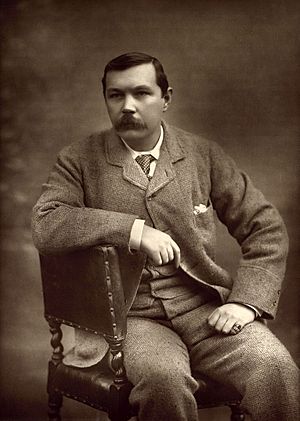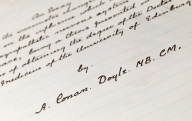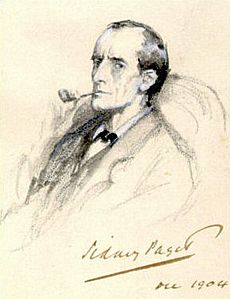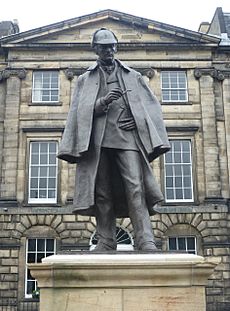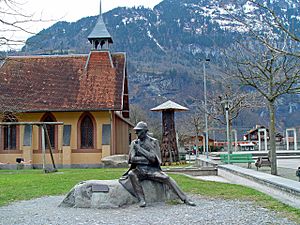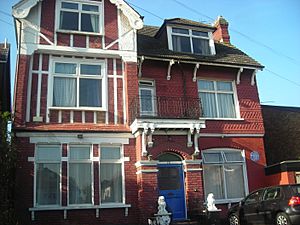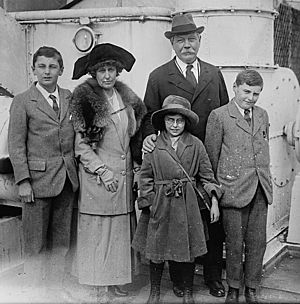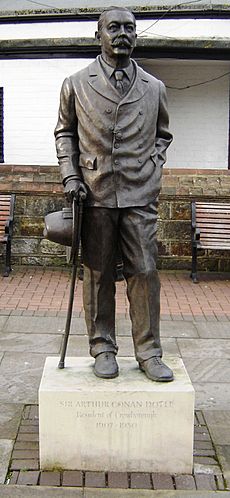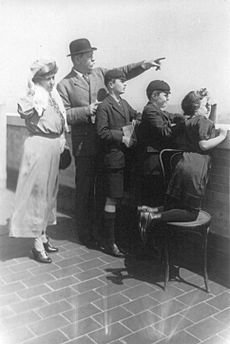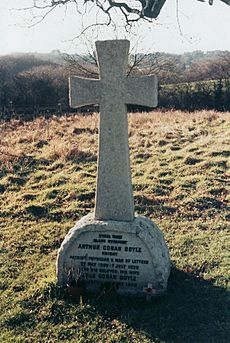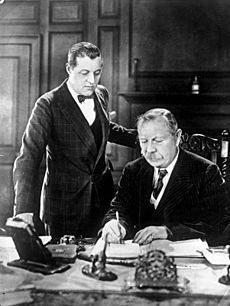Arthur Conan Doyle facts for kids
Quick facts for kids
Sir
Arthur Conan Doyle
KStJ DL
|
|
|---|---|
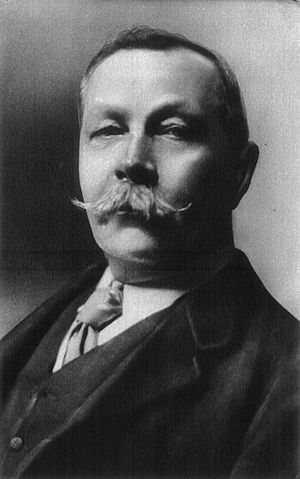
Arthur Conan Doyle in June 1914
|
|
| Born | Arthur Ignatius Conan Doyle 22 May 1859 Edinburgh, Scotland |
| Died | 7 July 1930 (aged 71) Crowborough, Sussex, England |
| Occupation |
|
| Education | University of Edinburgh |
| Genre |
|
| Notable works |
|
| Spouse |
|
| Children | 5 (including Adrian and Jean) |
| Signature | |
Sir Arthur Ignatius Conan Doyle (born May 22, 1859 – died July 7, 1930) was a famous British writer and doctor. He is best known for creating the detective Sherlock Holmes in 1887. This character first appeared in the book A Study in Scarlet.
Arthur Conan Doyle wrote four novels and 56 short stories about Sherlock Holmes and his friend Dr. Watson. These stories are very important in the world of crime fiction.
Doyle wrote many other things too. He created fantasy and science fiction stories about Professor Challenger. He also wrote funny stories about a soldier named Brigadier Gerard. His works include plays, love stories, poems, and historical novels. One of his early short stories, "J. Habakuk Jephson's Statement" (1884), helped make the mystery of the Mary Celeste ship very popular.
Contents
Early Life and Education
Arthur Conan Doyle was born in Edinburgh, Scotland, on May 22, 1859. His father, Charles Altamont Doyle, was from England, and his mother, Mary, was from Ireland.
When he was nine, Arthur was sent to a special school called Hodder Place in England. He then went to Stonyhurst College until he was 16. Doyle felt the school was very strict and focused only on old subjects like math and classics. He later said that this type of learning was like a "mental dumbbell" to make your mind stronger.
From 1875 to 1876, he studied in Austria to learn German. After this, he decided not to follow the Catholic faith he grew up with. He later became interested in spiritualism, which is the belief that spirits of the dead can communicate with the living.
Becoming a Doctor
From 1876 to 1881, Doyle studied medicine at the University of Edinburgh. During this time, he worked in different towns and also studied plants at the Royal Botanic Garden Edinburgh. While studying, he started writing short stories. His first published story, "The Mystery of Sasassa Valley", appeared in a magazine in 1879. He also published a medical article about a poison called "Gelsemium".
In 1880, Doyle worked as a doctor on a whaling ship called Hope. He sailed to Greenland and explored new lands. After finishing his medical degree in 1881, he worked as a ship's surgeon on a voyage to West Africa. He earned a higher medical degree in 1885.
In 1882, Doyle opened his own medical practice in Portsmouth. It was not very busy, so he spent his free time writing stories. He strongly believed in vaccination and wrote articles supporting it.
In 1891, Doyle went to Vienna to study eye medicine, but he found it too hard to understand the German lessons. He soon stopped his studies there and returned to London. He opened an eye doctor's office, but he didn't have any patients. This failure gave him more time to write.
Writing Career
Sherlock Holmes Stories
Doyle found it hard to get his first Sherlock Holmes story published. He wrote A Study in Scarlet in just three weeks when he was 27. A publisher bought all the rights to the story for £25. It was published in 1887 and got good reviews.
Sherlock Holmes was partly based on Doyle's old university teacher, Joseph Bell. Bell was very good at observing details and making smart guesses. Doyle wrote that he tried to create Holmes using Bell's methods.
Because A Study in Scarlet was popular, Doyle wrote a second Holmes story, The Sign of the Four, in 1890. He felt he was not paid enough for these first stories. So, he started publishing his Sherlock Holmes short stories in Strand Magazine, which paid him much better.
Doyle sometimes felt that Sherlock Holmes took up too much of his time. In 1891, he even thought about ending Holmes's stories for good. But his mother told him not to! Publishers were willing to pay a lot for more Holmes stories, so Doyle became one of the highest-paid writers of his time.
In 1893, Doyle decided to kill off Holmes and his enemy, Professor Moriarty, in the story "The Final Problem". They fell to their deaths at the Reichenbach Falls in Switzerland. People were very upset about this! Because of public demand, Doyle brought Holmes back in the 1901 novel The Hound of the Baskervilles.
In 1903, he published "The Adventure of the Empty House", explaining that only Moriarty had died at the falls. Holmes had pretended to die to escape other dangerous enemies. In total, Doyle wrote 56 short stories and four novels about Sherlock Holmes.
Other Books and Stories
Doyle wrote many other books besides the Holmes series. His first novels were The Mystery of Cloomber (1888) and The Narrative of John Smith. He also wrote short stories inspired by his time at sea, like "The Captain of the Pole-Star". His story "J. Habakuk Jephson's Statement" made the mystery of the Mary Celeste famous, even adding some fictional details that people now often believe are true.
Between 1888 and 1906, Doyle wrote seven historical novels. He and many critics thought these were his best works. These include The White Company and Sir Nigel, which are set in the Middle Ages. He also wrote stories about the grumpy scientist Professor Challenger, including the well-known The Lost World.
Doyle also wrote plays, including Waterloo and The Speckled Band, which was based on one of his own short stories.
Sports and Hobbies
Doyle was a keen sportsman. He played football as a goalkeeper for an amateur team in Portsmouth. He also loved cricket and played ten first-class matches for the Marylebone Cricket Club (MCC). He even played alongside other famous writers like J. M. Barrie and P. G. Wodehouse.
In 1900, Doyle started a rifle club at his home. He believed that people should learn to shoot to help their country. He also served as a judge for the world's first major bodybuilding competition in 1901.
Doyle was an amateur boxer and a keen golfer. He was even captain of the Crowborough Beacon Golf Club in 1910. He also enjoyed billiards.
While living in Switzerland, Doyle became interested in skiing, which was not very common there at the time. He wrote an article about his skiing experiences, which helped make the sport popular in Switzerland.
Family Life
In 1885, Doyle married Louisa Hawkins. She had tuberculosis, a serious lung disease. After Louisa died in 1906, he married Jean Elizabeth Leckie in 1907. He had met Jean in 1897 and loved her, but he waited to marry her out of loyalty to his first wife.
Doyle had five children. Two with his first wife: Mary Louise and Kingsley. Three with his second wife: Denis Percy Stewart, Adrian Malcolm, and Jean Lena Annette. None of his children had their own children, so he has no direct descendants alive today.
Public Service and Beliefs
During the Second Boer War in South Africa (1899–1902), Doyle worked as a volunteer doctor. After the war, he wrote a book called The Great Boer War. He also wrote a short work defending Britain's actions in the war. He believed this book was why King Edward VII made him a Knight Bachelor in 1902, giving him the title "Sir".
Doyle tried to become a Member of Parliament twice but was not elected. He was also a strong supporter of human rights. In 1909, he wrote The Crime of the Congo, which spoke out against the terrible things happening in the Congo colony. He even tried to help save a diplomat named Roger Casement, who was accused of treason.
As World War I approached, Doyle was one of many British authors who signed a statement supporting Britain's involvement in the war.
Legal Cases
Arthur Conan Doyle was also a strong believer in justice. He personally looked into two legal cases where men were wrongly accused. Thanks to his efforts, both men were proven innocent.
Spiritualism
Doyle was very interested in paranormal things and the idea of spirits. He believed that people could communicate with the dead.
In the 1920s, Doyle traveled to Australia, New Zealand, and the United States to give talks about his belief in spiritualism. He also wrote books about it, including The Coming of the Fairies (1922). In this book, he shared his beliefs about fairies and spirits.
Architecture and Design
Doyle also enjoyed designing buildings. In 1895, he helped design his own home, called Undershaw, in Surrey, England. He lived there from 1897 to 1907. This house later became a hotel and then was saved from being redeveloped. It is now part of a school for children with special needs.
In 1912, Doyle drew plans for an extension to a hotel. The building was built almost exactly as he designed it. In 1914, he even designed a golf course and buildings for a hotel in Canada, though these no longer exist.
In 1926, Doyle helped fund and laid the foundation stone for a Spiritualist Temple in London.
Death
Arthur Conan Doyle died on July 7, 1930, at his home in Crowborough, Sussex. He was 71 years old and died of a heart attack. His last words to his wife were: "You are wonderful."
Because he was a Spiritualist and not a Christian, there was some discussion about where he should be buried. He was first buried in his rose garden. Later, he and his wife were reburied together in a churchyard in Minstead, Hampshire. His gravestone says: "Steel true/Blade straight/Arthur Conan Doyle/Knight/Patriot, Physician and man of letters".
There are statues honoring Doyle in Crowborough, where he lived for many years, and in Edinburgh, near his birthplace.
Honours and Awards
 Knight Bachelor (1902)
Knight Bachelor (1902) Knight of Grace of the Most Venerable Order of the Hospital of Saint John of Jerusalem (1903)
Knight of Grace of the Most Venerable Order of the Hospital of Saint John of Jerusalem (1903) Queen's South Africa Medal (1901)
Queen's South Africa Medal (1901) Knight of the Order of the Crown of Italy (1895)
Knight of the Order of the Crown of Italy (1895) Order of the Medjidie – 2nd Class (Ottoman Empire) (1907)
Order of the Medjidie – 2nd Class (Ottoman Empire) (1907)
Commemoration
Arthur Conan Doyle has been honored with statues and plaques since his death. In 2009, he was one of ten famous Britons chosen for a special postage stamp issue by the Royal Mail.
Portrayals
Arthur Conan Doyle has been played by many actors in movies and TV shows:
Television Series
- Nigel Davenport in The Edwardians (1972)
- Michael Ensign in Voyagers! (1983)
- Robin Laing and Charles Edwards in Murder Rooms: Mysteries of the Real Sherlock Holmes (2000–2001)
- Geraint Wyn Davies in Murdoch Mysteries (2008–2013)
- David Calder in Houdini (2014)
- Martin Clunes in Arthur & George (2015)
- Stephen Mangan in Houdini & Doyle (2016)
- Michael Pitthan in Charité (2017)
- Bill Paterson in Urban Myths (2018)
Television Films
- Peter Cushing in The Great Houdini (1976)
- David Warner in Houdini (1998)
- Richard Wilson in Reichenbach Falls (2007)
- Michael McElhatton in Agatha and the Truth of Murder (2018)
Theatrical Films
- Paul Bildt in The Man Who Was Sherlock Holmes (1937)
- Peter O'Toole in FairyTale: A True Story (1997)
- Edward Hardwicke in Photographing Fairies (1997)
- Tom Fisher in Shanghai Knights (2003)
- Ian Hart in Finding Neverland (2004)
Other Media
- Carleton Hobbs in the BBC radio drama Conan Doyle Investigates (1972)
- Iain Cuthbertson in the BBC radio drama Conan Doyle and The Edalji Case (1987)
- Peter Jeffrey in the BBC radio drama Conan Doyle's Strangest Case (1995)
- Adrian Lukis in the stage play Arthur & George (2010)
- Chris Tallman in The Dead Authors Podcast (2012)
- Steven Miller in the Jago & Litefoot audio drama (2014)
- Eamon Stocks in the video game Assassin's Creed Syndicate (2015)
- Ryohei Kimura in the mobile game Ikémen Vampire: Temptation in the Dark (2019)
In Fiction
- Arthur Conan Doyle is a character in Ian Madden's short story "Cracks in an Edifice of Sheer Reason".
- He also appears as a character in Pip Murphy's Christie and Agatha's Detective Agency series, including A Discovery Disappears.
See Also
 In Spanish: Arthur Conan Doyle para niños
In Spanish: Arthur Conan Doyle para niños
- William Gillette, a friend who played Sherlock Holmes on stage.
- List of notable Freemasons
- Physician writer


